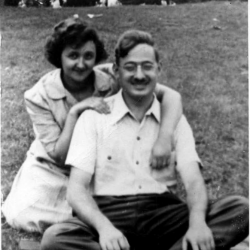
On October 13, 1952, the United States Supreme Court denied certiorari - that is declined to review the record - in my parents’ case for the first time. Under federal law, anyone convicted of a criminal offense has the right to have their appeal heard by the United States Circuit Court of Appeals for the circuit in which the trial court sits. Since my parents’ trial was held in the Federal District Court of the Southern District of New York (March 1951), their appeal was heard and denied by the Second Circuit Court of Appeals in February 1952.
Also under our federal rules, a criminal defendant has the right to petition the Supreme Court for review of the Circuit Court’s decision. But with certain exceptions, which don’t apply here, at least four Justices of the Supreme Court must agree to grant certiorari before the review can take place. Only one Justice, Hugo Black, voted to hear the case in response to my parents’ first application. Ultimately, they applied for certiorari nine times, garnering as many as three votes from the Justices to hear the case, but they never obtained that crucial, and possibly life-saving, fourth vote.
The Supreme Court’s refusal to review the record in my parents’ case on nine separate occasions generated a controversy over 20 years later that might have been somewhat amusing if it weren’t about something so deadly serious. In 1973, famed trial lawyer, Louis Nizer, published The Implosion Conspiracy, a book about my parents’ case. His thesis was that my parents were guilty, but the sentence of death against them was excessive. He reached his conclusion of guilt by answering just one question: Was the evidence presented to the jury at the Rosenbergs’ trial sufficient to support their conviction? He never even considered the possibility that the evidence was tainted.
Nizer also claimed that 112 judges had reviewed my parents’ conviction and none discounted its validity. My brother and I had to chuckle when we found out how he had arrived at this figure. Since my parents had applied for Supreme Court review nine times, and there were nine Justices on the Supreme Court, Nizer concluded that 81 judges had upheld my parents’ conviction. In other words, Nizer counted nine judges who refused to review the case, several of whom had actually voted to review it, as 81 judges who upheld my parents’ conviction. He also inflated the number of remaining judges (112-81=31) with similar counting shenanigans around each denial of my parents’ multiple appeals to three-judge panels of the Second Circuit.
The fact that Louis Nizer, a political liberal considered by many to be one of the great trial lawyers of the 1950’s, would stoop to such sleight of hand to “prove” that, for the most part, the courts functioned properly in the Rosenberg case, sheds a lot more light on one liberal’s apology for the system than it does on my parents’ culpability. And, of course, the fact remains, the Supreme Court never reviewed the fairness of my parents’ trial or any other aspect of the record in the case.
-------------------------
To receive a notification whenever there is a new post to Out on a Limb Together, subscribe now.

Comments
your parents
I like to try to keep up with anything having to do with your parents. I am ninety years old and still have my faculties, but that is about all I have left. I am glad that you and your brother are still active in the case. Peace flora goldman
Same as above
Nice to see Ms Goldman's comment above;
Good to know there are people that know and that care....
And those of us that carry on...
In Solidarity.; Leeza V
Dogged determination
I admire your dogged determination to inform people about the injustice in the case of your parents, who could just as well have been MY parents. The "holes" in the government's case, and the holes in the work of some people writing about the case, could be described as "fascinating," or "curious," if the whole thing weren't, as you say, so deadly serious.